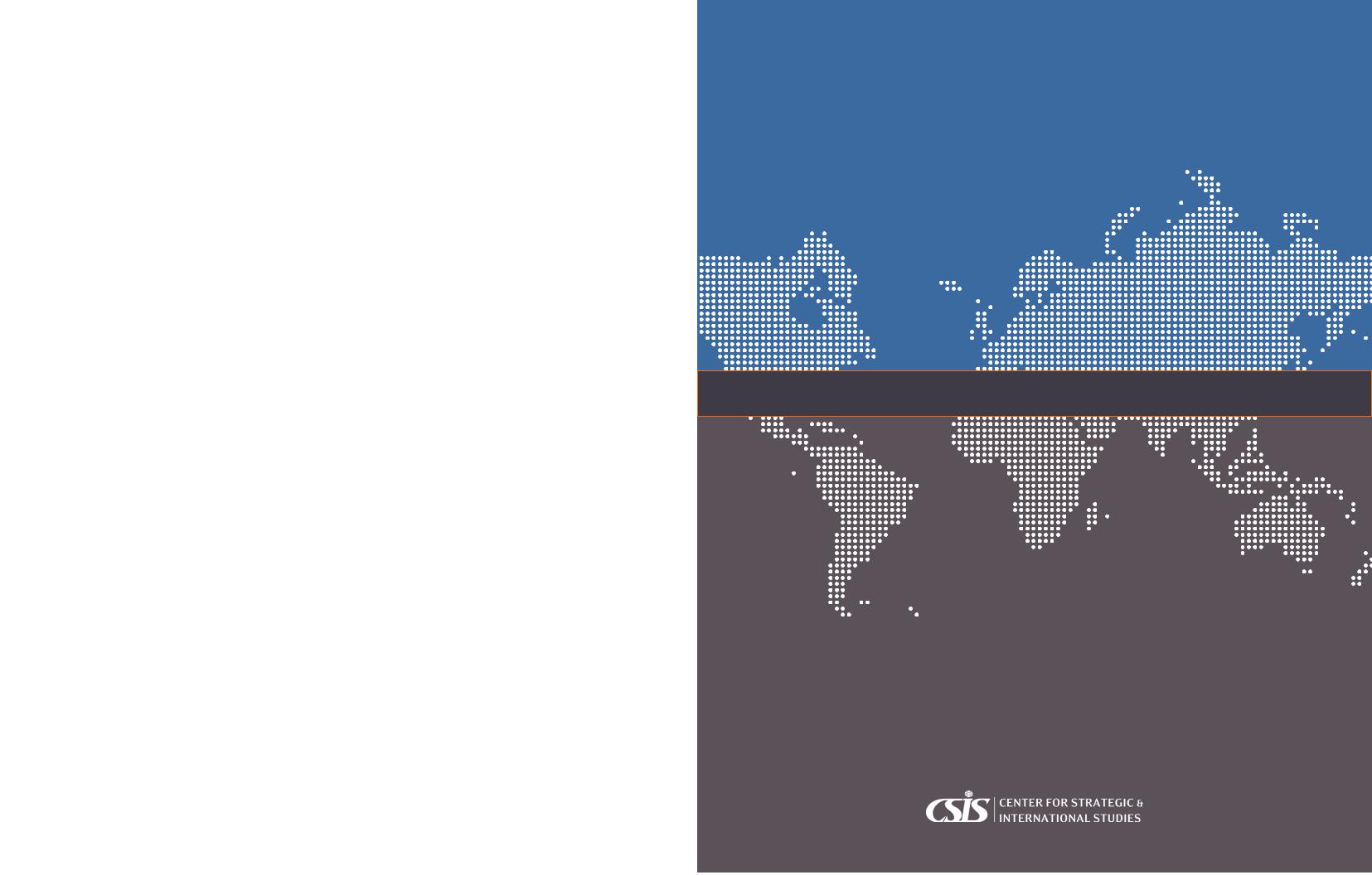
embassy_future
.pdf







 T H E E M B A
T H E E M B A S
S S
S Y
Y
 O
O F
F
 T
T H
H E
E
 F
F U
U T
T U
U R
R E
E





George L. Argyros
Marc Grossman
Felix G. Rohatyn
Commission Cochairs
Anne Witkowsky
Project Director

ABOUT CSIS
The Center for Strategic and International Studies (CSIS) seeks to advance global security and prosperity in an era of economic and political transformation by providing strategic insights and practical policy solutions to decisionmakers. CSIS serves as a strategic planning partner for the government by conducting research and analysis and developing policy initiatives that look into the future and anticipate change. Our more than 25 programs are organized around three themes:
Defense and Security Policy—With one of the most comprehensive programs on U.S. defense policy and international security, CSIS proposes reforms to U.S. defense organization, defense policy, and the defense industrial and technology base. Other CSIS programs offer solutions to the challenges of proliferation, transnational terrorism, homeland security, and post-conflict reconstruction.
Global Challenges—With programs on demographics and population, energy security, global health, technology, and the international financial and economic system, CSIS addresses the new drivers of risk and opportunity on the world stage.
Regional Transformation—CSIS is the only institution of its kind with resident experts studying the transformation of all of the world’s major geographic regions. CSIS specialists seek to anticipate changes in key countries and regions—from Africa to Asia, from Europe to Latin America, and from the Middle East to North America.
Founded in 1962 by David M. Abshire and Admiral Arleigh Burke, CSIS is a bipartisan, nonprofit organization headquartered in Washington, D.C., with more than 220 full-time staff and a large network of affiliated experts. Former U.S. senator Sam Nunn became chairman of the CSIS Board of Trustees in 1999, and John J. Hamre has led CSIS as its president and chief executive officer since 2000.
CSIS does not take specific policy positions; accordingly, all views expressed herein should be understood to be solely those of the author(s).
© 2007 by the Center for Strategic and International Studies. All rights reserved.
Library of Congress Cataloging-in-Publication Data
The Embassy of the future / project cochairs, George L. Argyros, Marc Grossman, Felix G. Rohatyn ; project director, Anne Witkowsky.
p. cm.
Includes bibliographical references.
ISBN 978-0-89206-508-0 (pbk. : alk. paper) 1. United States—Foreign relations administration.
2. Information technology—United States. I. Argyros, George L. II. Grossman, Marc, 1951– III. Rohatyn, Felix G., 1928– IV. Witkowsky, Anne. V. Center for Strategic and International Studies (Washington, D.C.) VI. Title.
JZ1480.E43 2007 |
|
353.1’30973—dc22 |
2007031146 |
The CSIS Press
Center for Strategic and International Studies 1800 K Street, N.W., Washington, D.C. 20006
Tel: (202) 775-3119 |
Fax: (202) 775-3199 |
E-mail: books@CSIS.org |
Web: www.csis.org |
CONTENTS |
|
|
Members, Embassy of the Future Commission |
II |
|
Project Staff |
III |
|
Preface |
IV |
|
Executive Summary |
VI |
|
Introduction: A New American Diplomacy |
1 |
|
The Embassy of the Future |
4 |
|
RECOMMENDATIONS |
|
|
1. |
Invest in People |
8 |
2. |
Integrate Technology and Business Practices |
15 |
3. |
Expand Knowledge and Information Sharing |
19 |
4. |
Embrace New Communications Tools |
23 |
5. |
Operate beyond Embassy Walls |
27 |
6. |
Strengthen Platform and Presence Options |
31 |
7. Strengthen the Country Team |
47 |
|
8. |
Manage Risk |
50 |
9. Promote Secure Borders, Open Doors |
55 |
|
10. |
Streamline Administrative Functions |
58 |
APPENDIXES |
|
|
Appendix A: About the Commission Members |
60 |
|
Appendix B: Presenters at Full Commission Meetings |
65 |
|
Appendix C: Working Session Participants and Other Contributors |
66 |
|
Appendix D: Interviews |
69 |
|
Glossary |
72 |
|

MEMBERS, EMBASSY OF THE FUTURE COMMISSION
The Center for Strategic and International Studies expresses its gratitude to the members of the commission:
Cochairs |
LTG James R. Clapper, USAF (Retired)* |
George L. Argyros |
Under Secretary of Defense for Intelligence |
Chairman and CEO |
U.S. Department of Defense |
Arnel & Affiliates |
James Dyer |
|
|
Marc Grossman |
Consultant |
Vice Chairman |
Clark & Weinstock |
The Cohen Group |
Stuart E. Eizenstat |
|
Felix G. Rohatyn
Senior Adviser to the Chairman and Chairman of the International Advisory Committees Lehman Brothers
Commissioners
Richard L. Armitage
President
Armitage International
Anne L. Armstrong
Vice Chairman of the Executive Committee Center for Strategic and International Studies
Kenneth H. Bacon
President
Refugees International
Stuart A. Bernstein
Former Ambassador
Keith L. Brown
Chairman
Council of American Ambassadors
Prudence Bushnell
CEO
Sage Associates
Partner
Covington & Burling
Charles A. Gillespie, Jr.
Principal
The Scowcroft Group
Louis W. Goodman
Dean and Professor of International Relations,
School of International Service
American University
Jamie Gorelick
Partner
WilmerHale
A. Elizabeth Jones
Executive Vice President
APCO Worldwide
James R. Jones
Cochairman and CEO
ManattJones Global Strategies
Kenton W. Keith
Senior Vice President
Meridian International Center
* LTG Clapper served on the commission until April 2007, when he returned to government service.
I I T H E E M B A S S Y O F T H E F U T U R E

Alan P. Larson |
ADM Joseph W. Prueher, USN (Retired) |
|
Senior International Policy Adviser |
Consulting Professor and Senior Adviser |
|
Covington & Burling |
Stanford University Center for International |
|
Tara Lemmey |
Security and Cooperation (CISAC) |
|
|
||
CEO |
Cynthia P. Schneider |
|
LENS Ventures |
Distinguished Professor in the Practice |
|
W. Robert Pearson |
of Diplomacy, School of Foreign Service |
|
Georgetown University |
||
Head, International Division |
||
|
||
The SPECTRUM Group |
BGN Francis X. Taylor, USAF (Retired) |
|
Thomas R. Pickering |
Chief Security Officer |
|
General Electric Company |
||
Vice Chairman |
||
|
||
Hills & Company |
|
PROJECT STAFF
Staff |
Eric Lief |
|
Anne Witkowsky |
Senior Associate |
|
Senior Fellow and Project Director |
Mark Wong |
|
|
||
Peter Roady |
U.S. Department of State (Retired) |
|
Research Assistant |
|
|
Kate Phillips |
Interns |
|
Jessica Berlow |
||
Research Associate |
||
|
||
|
Brenna Dion |
|
Ashley Rasmussen |
Laura Gunderson |
|
Project Coordinator |
||
|
||
|
Zack Kahn |
|
Contributors |
Alexandra Knatchbull |
|
James A. Lewis |
Anand Prakash |
|
|
||
Senior Fellow and Director |
|
|
Technology and Public Policy Program |
|
M E M B E R S , E M B A S S Y O F T H E F U T U R E C O M M I S S I O N & P R O J E C T S T A F F I I I

PREFACE
The CSIS Embassy of the Future project was launched in the fall of 2006 to explore the tension between protecting U.S. diplomats and enabling them to conduct their missions effectively. How can both diplomatic platforms and practices meet security objectives and best serve America? How should the State Department equip and empower U.S. diplomats with the benefits of twenty-first century technology?
CSIS invited three highly respected individuals to serve as the study’s cochairs—George L. Argyros, Marc Grossman, and Felix G. Rohatyn—each of whom drew on his experience as an ambassador to lead our discussions and investigation. CSIS expresses its gratitude to the 25 distinguished com-
missioners who participated, including former senior government officials, former career ambassadors and noncareer ambassadors, retired military officers, private-sector representatives, and academic experts.
This project developed from discussions between Henrietta Holsman Fore, undersecretary of state for management, and Dr. John Hamre, president and CEO of CSIS. The commission and staff owe Under Secretary Fore a special debt of gratitude for her active support of the project. The State Department cooperated extensively with the commission, but the findings and recommendations are those of
the commission.
The study was funded by the Una Chapman Cox Foundation, an organization dedicated to furthering the U.S. Foreign Service. The project benefited from the generous encouragement and support of the foundation’s trustees and in particular from its executive director Ambassador Clyde Taylor.
The commission’s goal was to create a vision for an embassy of the future that could be realized by implementing practical recommendations for today. Participants looked at how the diplomat’s job is changing and then at the training, platforms, technology, and business practices that tomorrow’s diplomats will need to promote and protect
U.S. interests.
The commission met formally three times: in October 2006 to obtain baseline information and chart the project’s course; in March 2007 to discuss draft findings and recommendations; and in May 2007 to review the draft final report. In June 2007, commission representatives twice briefed the secretary of state and her senior staff on the commission’s draft recommendations.
Project research was conducted in Washington and overseas. CSIS convened four working sessions: the first session addressed how the diplomacy of the future will shape the needs for the embassy of the future; the second examined business models for overseas presence; the third discussed diplomatic platforms and presence—from bricks and mortar to online outreach; and the fourth explored new technology. Working session participants included commissioners, current and former State Department and other government personnel, and other outside experts.
CSIS staff conducted a number of focus group meetings in Washington to generate and review ideas for the project. These groups were composed of current State Department personnel ranging from young professionals through senior management. CSIS staff also interviewed a number of private-
I V T H E E M B A S S Y O F T H E F U T U R E

sector executives to learn from industry models for overseas operations and consulted with experts from across the substantive scope of the project. We thank them for their generous time and insights.
Commissioners and staff together engaged in an extensive program of fact-finding overseas, conducting interviews with dozens of individuals at 37 posts. While traveling overseas on other business, commissioners devoted personal time to the project and met people at 13 overseas posts. Commissioners, CSIS staff, and experts interviewed posts widely via videoconference and telephone. We are grateful to all the personnel stationed at posts around the world who bent their schedules around time zones to convene for the videoconference interview sessions, hosted visiting commissioners and staff, and otherwise made themselves freely available to discuss the embassy of the future.
The report builds on a long line of distinguished studies on diplomacy and overseas presence. We express appreciation to Lewis Kaden and the 1999 report of the Overseas Presence Advisory Panel, which inspired our own approach.
The commission and staff express appreciation to all those who presented at the full commission sessions and in the working sessions, as well as to those working session participants who shared their time, talent, and wisdom. These individuals are identified by name in the appendix. We are grateful to the numerous State Department officials who assisted with information, expertise, and insight. We thank Frank Coulter, Ruth Whiteside, Gretchen Welch, Susan Swart, Susan Jacobs, Larry Richter, Phil Lussier, Anne Carson, Allison Shorter-Lawrence, and Tim Cipullo. Rudolph Lohmeyer and the State Department’s Project Horizon team provided valuable perspective. Many outside experts provided
important insights as well; we thank especially Amy Weinstein, Ed Feiner, Donald Hays and Steven Pifer.
Post interviews were supported with the expert contributions of the Executive Potential Program group. Ashley Rasmussen, our project coordinator, and our project interns served as key members of the team. We thank Vinca LaFleur for her fine editing skills. Kate Phillips played a critical role in bringing the project to closure. Finally, none of this would have been possible without Peter Roady, the project’s talented research assistant.
Most of the commission’s recommendations were drawn from ideas provided by individuals with whom the commission and staff met over the past year. The commission is deeply grateful to all those who gave generously of their time and insight throughout the duration of the project.
P R E F A C E V

EXECUTIVE SUMMARY
The truest test of the value to our nation of the U.S. diplomatic presence abroad is whether the people we ask to represent us effectively promote American values and interests.
Diplomacy is a vital tool of national security. The aim of this report is to make the diplomatic pursuit of U.S. interests abroad even more effective than it is today. Our diplomats and those who support them must have the right tools and capacity to do their work. This is an urgent national priority. Transnational threats, including terrorism, put U.S. citizens and national interests at risk. Potential competitor nations are emerging on the global stage. AntiAmericanism can have lethal consequences for
our nation and its citizens. Operating in a higherthreat environment is part of today’s diplomatic job. Traditional diplomacy—where government and social elites interact in highly formal channels—is being transformed. U.S. diplomats will still need to influence foreign governments, but increasingly they will work directly with diverse parts of other nations’ societies. The Embassy of the Future Commission envisions an embassy presence in which U.S. officials reach out broadly, engage societies comprehensively, and build relationships with key audiences effectively.
This project is called the “Embassy of the Future,” but “embassy” is meant in a broad sense, of which embassy buildings are only one dimension. The commission underscores that the U.S. presence and our diplomacy are about our people—Foreign Service, Civil Service, Foreign Service nationals and other locally employed staff—and their capacity to carry out their mission.
We want to empower U.S. diplomats to succeed in the work they do for America. Modernization and reform of the diplomatic profession and its infrastructure have begun. But the State Department must do more. The department needs more people and a well-trained workforce; modern technology that will expand diplomatic capacity and reach; policies, communications tools, and resources that support mobility outside embassy compounds; platforms that serve mission effectiveness; and a risk-managed approach to security that allows for the interactions in the field required to achieve successful diplomatic engagement. To do so, we propose the following ten recommendations:
3Invest in people. The security of the United States depends on the capacity of its diplomats to carry out the nation’s business. The State Department must hire more than 1,000 additional diplomats—a 9.3 percent increase—so that it can fill positions at home and abroad while providing the education and development programs that twenty- first-century representatives of the United States need to reach their potential. Professional education and development programs must be enhanced across the board. The State Department must also, where possible, make greater use of the foreign national component of its workforce at posts overseas.
3Integrate technology and business practices.
Senior department leadership needs to raise the profile of technology within the State Department and place technology more effectively in the service of business practices. The department must fund technology more consistently across its bureaus. To
V I T H E E M B A S S Y O F T H E F U T U R E

help the State Department develop strategies for the application of technology in support of new business practices, the commission recommends the appointment of a chief innovation officer. The department should also establish a Technology Center at the National Foreign Affairs Training Center that would serve as a demonstration and instruction facility for technology and new business practices; partner the center with embassies as test beds for technology innovation; and establish a special fund for technology innovation at posts.
3Expand knowledge and information sharing. Knowledge and information sharing are indispensable to organizational success. As an infor- mation-producing, knowledge-rich organization, the State Department must do a much better job of sharing both. Best-practices sharing needs to
be vastly expanded, together with the significant expansion of virtual communities of practice as a tool for reporting and sharing information. The State Department should implement an organization-wide relationship management system and improve its search and retrieval capabilities for digitized material. The use of videoconferencing should be expanded.
3Embrace new communications tools. The State Department must exploit Internet-based media such as online discussion forums and video-sharing services, which are changing the way people interact with one another around the world. The State Department should enhance its embassy Web sites in line with other content-rich Web sites, train
its officers in the strategic use of these forms of outreach, and develop and distribute more content using these new tools.
3Operate beyond embassy walls. U.S. diplomats must work effectively and routinely outside the embassy compound. Policies within the State Department and at embassies must value and
support this work. Mobile communications capabilities should be available to all personnel, together with sufficient resources for travel and outreach.
3Strengthen platform and presence options.
The commission recommends a comprehensive, distributed presence around the world that will allow for a broader and deeper engagement with governments, opinion leaders, and the global public. Designing this presence in each country should begin at post, tailored to local needs, and coordinated with the relevant State Department bureau. The commission advocates the founding of a federally funded research and development center (FFRDC) to support the task of analyzing the overseas requirements for this presence.
The current State Department construction program for diplomatic facility replacement needs to be continued. Embassies and consulates must be modern, safe, and functional places to work. They must not only protect diplomats, but also advance the diplomatic mission. Locations remote from urban centers should be avoided wherever possible.
Building on initiatives already under way, the State Department should strengthen, develop, and fund options for extending the diplomatic presence in capitals and outside them. These include American Presence Posts, traveling circuit riders, and Virtual Presence Posts as well as American Corners and American Centers.
3Strengthen the country team. Large
interagency country teams and a distributed presence pose increasing challenges for the ambassador’s leadership. Interagency cooperation at overseas posts is essential for the embassy of the future. The critical component of success will be the capacity of ambassadors and deputy chiefs of mission to lead. Ambassadors’ authorities as the president’s personal representative should be codified in an executive
E X E C U T I V E S U M M A R Y V I I

order. Organizational structures, the physical layout of embassies, and personnel practices should be designed to encourage a high degree of cooperation and coordination among the representatives of all agencies at post. All agency representatives must be able to readily communicate across their respective information systems.
3Manage risk. To support a diplomatic presence that is distributed, the department’s security culture and practices must continue to transition from risk avoidance to risk management. The secretary of state should begin a dialogue within the State Department, with the Congress, and among other interested parties on this serious challenge. Ambassadors’ instructions from the president need to be revised to reflect this need for engagement and the risk it can entail. All diplomats need security skills training throughout their careers, beginning at the time of their entry to the department. Diplomats’ families also need this training. Security officers should be well trained in diplomatic practice, and more must have language training. Finally, the State Department must provide care for its people who serve in the most challenging assignments.
3Promote secure borders, open doors. With
the post-9/11 removal of the waiver for personal appearances for nonimmigrant visas, together with increased visa workloads, embassies face big challenges in managing their visitors. The United States should have welcoming consular waiting areas that showcase our country. The State Department should continue testing its remote visa interviewing program and explore traveling consular services to create more distributed consular operations.
3 Streamline administrative functions. The State Department must continue the process of streamlining and standardizing its administrative functions and consolidating them regionally. There should be renewed emphasis on making administrative processes in support of diplomacy more efficient and cost effective.
Projecting U.S. influence through diplomatic engagement requires a serious commitment of funds. The State Department must take a consistent approach to working with Congress if it is to receive these resources.
The men and women who represent the United States abroad serve with skill and dedication, often under dangerous and difficult circumstances. The commission wants this study to enhance their capacity to promote, protect, and defend the nation’s interests. The commission believes that these ten practical recommendations will result in a more effective U.S. diplomacy.
V I I I T H E E M B A S S Y O F T H E F U T U R E
